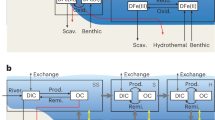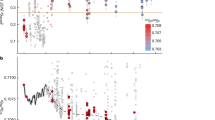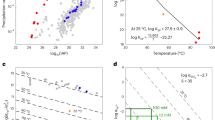Summary
The advent of biomineralization at the turn of the Precambrian/Cambrian boundary has been a major event in the Earth's evolutionary history. With this there has been a major shift from abiotic to biotic formation of minerals such as phosphates and carbonates and, subsequently, silica. The dominant factor which effected this shift is a change in ocean's chemistry with respect to its Ca2+ and mineral nutrient contents. Mechanism controlling the biotic mineral formation is different from that controlling the abiotic one in that the former is enzymically controlled. It is suggested that this difference is also manifested in the stable carbon isotope fractionation between the two processes and has implication for the interpretation of stable carbon isotope record.
Zusammenfassung
Im exogenen Kreislauf können die Bildung von Karbonaten
-
(i)
chemisch Ca2++2HCO −3 →CaCO3+CO2+H2O und
-
(ii)
biochemisch Ca2++2HCO −3 →Ca(HCO3)2)→CaCO3+H2CO3 gesteuert werden.
Die chemische Bildung (i) führt zu einer Isotopenfraktionierung, wobej, das erzeugte Karbonat um+4 und das freiwerdende CO2 um−4 gegenüber dem Bikarbonat fraktioniert wird. Die biochemische Bildung ist dagegen enzymisch gesteuert, wobei die beteiligte Karbonanhydrase nicht das CO2, sondern H2CO3 als Substrat gebraucht. Entsprechend wird das Isotopensignal des gelösten Karbonats konservativ an das Karbonat bzw. Karbonsäure unfraktioniert weitergegeben, da nur das CO3-Molekül beteiligt ist.
Diese Unterschiede sind bislang bei der Auswertung der13C/12C-Verteilung in Karbonaten so gut wie unberücksichtigt gebheben. In der vorliegenden Arbeit wird versucht, die Kohlenstoffisotopensignale mariner Karbonate unter Berücksichtigung chemischer und enzymischer Prozesse zu deuten. Dabei zeigt sich, daß vom Archaikum bis zum Vendium die Karbonatgeochemie ausschließlich chemisch gesteuert war. Mit dem Einsetzem der Biomineralisation, also der enzymisch-gesteuerten CaCO3-Bildung etwa and der Grenze zwischen Präkambrium/Kambrium, wurde die Karbonatchemie des Ozeans nahezu ausschließlich über die Organismen reguliert. Damit steht gleichzeitig auch das globale CO2-System unter biologischer Kontrolle.
Similar content being viewed by others
References
Arthur, M. A., Dean, W. E., Schlanger, S. O., 1985: Variations in the global carbon cycle during the Cretaceous related to climate, volcanism and changes in the atmospheric CO2. In: The Carbon Cycle and Atmospheric CO2: Natural Variations Archean to Present (Sundquist, E. T., Broecker, W. S., eds.), pp. 504–529, Washington, D. C.: Amer. Geophys. Union.
Degens, E. T., 1976: Molecular mechanisms on carbonate, phosphate and silica deposition in the living cell. Topics in Current Chemistry,64, 3–112.
— 1969: Biogeochemistry of stable carbon isotopes. In: Organic Geochemistry (Eglinton, G. Murphy, M. T. J., eds.), pp. 304–329. Berlin-Heidelberg-New York: Springer.
Degens, E. T., Kazmierczak, J., Ittekkot, V., 1985: Cellular response to Ca2+ stress and geological implications. Acta Paleontol. Polonica30 (In press).
—,Kempe, S., Spitzy, A. 1984: CO2: A biogeochemical portrait. In: Handbook of Environmental Chemistry. (Hutzinger, O. ed.),. pp. 127–215. Berlin-Heidelberg-New York: Springer.
Deuser, W. G., Degens, E. T., 1969: O18/O16 and C13/C12 ratios of fossils from the hot brine deep area of the central Red Sea. In: Hot Brines and Recent Heavy Metal Deposits in the Red Sea (Degens, E. T., Ross, D. A., eds.), pp. 336–347. New York: Springer.
Emrich, K., Ehhalt, D., Vogel, J. C., 1970: Carbon isotope fractionation during the precipitation of calcium carbonate. Earth and Planet. Sci. Lett.,8, 363–371.
Golubic, S. 1973: The relationship, between blue-green algae and carbonate deposits In: The Biology of Blue-Green Algae (Carr, N. G., Whitton, B. A., eds.), pp. 434–472. Oxford: Blackwell
Goreau, T. F. 1959: The physiology of skeletal formation in corals I. A. method for measuring the rate of calcium deposition by corals under different conditions. Biol. Bull.116, 59–75.
Hallstead, L. B., 1969: Are mitochondria directly involved in biological mineralization (the mitochondrion and the origin of bone). Calc. Tiss. Res.3, 103–104.
Hutchinson, G. E., 1961: The biologist poses some problems. In: Oceanography (Sears, M., ed.), pp. 85–94, AAAS Publ. 67.
Jones, A. R., 1969: Mitochondria, calcification and waste disposal,. Calc. Tiss. Res.3, 363–365.
Kazmierczak, J., Ittekkot, V., Degens, E. T., 1985.: Biocalcification through time: Environmental challenge and cellular response. Paläontol. Z.59, 15–33.
Kempe, S., Degens, E. T., 1985: An early soda ocean? Chem. Geol.53, 95–108.
Koenig, S. H., Brown, R. D., 1972: H2CO3 as substrate for carbonic anhydrase in the dehydration of HCO −13 . Proc. Nat. Acad. Sci., U.S.A.69, 2422–2425.
Krampitz, G., Witt, W., 1979: Biochemical aspects of biomineralization. Topics in Current Chemistry78, 57–144.
Krumbein, W. E. 1979: Calcification by bacteria and algae. In: Biogeochemical Cycling of Mineral-forming Elements (Trudinger, P. A., Swain D. J., eds.), pp. 47–68. Amsterdam: Elsevier.
MacLaren, S. L., 1983: Bolides and biostratigraphy. Geol Soc. Amer. Bull.94, 313–324
Magaritz, M., Anderson, R. Y., Holser, W. T., Saltzman, E. S., Garber, J., 1983: Isotope shifts in the Late Permian of the Delaware Basin, Texas precisely timed by varved sediments. Earth and Planet. Sci. Lett.66 111–124.
Mook, W. G., Bommerson, J. C., Staverman, W. H., 1974: Carbon isotope fractionation between dissolved bicarbonate and gaseous carbon dioxide. Earth and Planet. Sci. Lett.22, 169–176.
Officer, C. B., Drake, C. L., 1983: The Cretacous-Tertiary transition. Science219, 1383–1390.
Schidlowski, M., 1982: Content and isotopic composition of reduced carbon in sediments. In: Mineral Deposits and Evolution of the Biosphere (Holland, H. D., Schidlowski, M., eds.), pp. 103–122. Berlin-Heidelberg-New York: Springer.
Shackleton, N., Hall, M. A., 1984: Carbon isotope data from Leg 74 sediments. In: Init. Repts. DSDP, 74 (Moore, T. C. Jr, Rabinowitz, P. E., et al., eds.), pp. 613–619. Washington, D.C.: U.S. Govt. Printing Office.
Shapiro, R. M., Greenspan, J. S., 1969: Are mitchrondria directly involved in biological mineralization? Calc. Tiss. Res.3, 100–102.
Simkiss, K., 1977: Biomineralization and detoxification. Calc. Tiss. Res.,24, 199–200.
Spitzy, A., Degens, E. T., 1985: Modelling stable isotope fluctuations through geologic time. Mitt. Geol-Paläontol. Inst. Univ. Hamburg59, 155–166.
Stanley, S. M., 1976: Fossil data and the Precambrian-Cambrian evolutionary transition. Amer. J. Sci.276, 56–76.
Taylor, H. P., Jr, Frechen, J., Degens, E. T., 1967: Oxygen and carbon isotope studies of carbonatites from the Laacher See District, West Germany, and the Alnö District, Sweden. Geochim. Cosmochim Acta,31, 407–416.
Thode, H. G., Shima, M., Rees, C. E., Krishnamurty, K. V., 1965: Carbon-13 isotope effects in systems containing carbon dioxide, bicarbonate, carbonate and metal ions. Canad. J. Chem.43, 582–589.
Towe, K. M., Cifelli, R., 1967: Wall ultrastructure in the calcareous,, foraminifera: Crystallographic aspects and a model for calcification. J. Paleontol.41, 742–776.
Urist, M. R., 1964: The origin of bone. Discovery25, 13–19.
Veizer, J., 1985: Carbonates and ancient oceans: Isotopic and chemical records on time scales of 107–109 years. In: The Carbon Cycle and Atmospheric CO2: Natural Variations Archean to Present (Sundquist, E. T., Broecker, W. S. eds.) pp. 595–601. Washington, D. C.: Amer. Geophys. Union.
—,Holser, W. T., Wilgus, C. K., 1980: Correlation, of13C/12C and34S/32S secular variations. Geochim. Cosmochim. Acta44, 579–587.
Westbroek, P., de Jong, E. W. eds. 1983: Biomineralization and Biological Metal Accumulation, 533, pp. Dordrecht: D. Reidel
Worley, T. R., Moody, J. B., Nance, R. D., 1985: Proterozoic to recent tectonic tuning of biogeochemical cycles. In: The Carbon Cycle and Atmospheric CO2: Natural Variations Archean to Present (Sundquist, E. T., Broecker, W. S., eds.), pp. 561–572. Washington, D. C.:Amer. Geophys. Union.
Zajic, J. E., 1969: Microbial Biochemistry, 345 pp. New York: Academic Press.
Author information
Authors and Affiliations
Additional information
With 5 Figures
Rights and permissions
About this article
Cite this article
Degens, E.T., Kazmierczak, J. & Ittekkot, V. Biomineralization and the carbon isotope record. TMPM Tschermaks Petr. Mitt. 35, 117–126 (1986). https://doi.org/10.1007/BF01140843
Received:
Accepted:
Issue Date:
DOI: https://doi.org/10.1007/BF01140843




